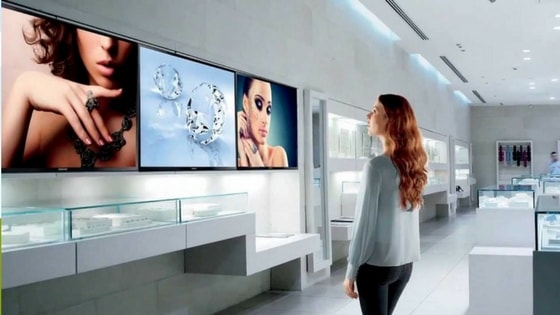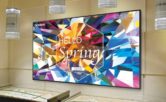Regular TV vs Commercial Display? Which is good for Digital Signage? Many people have asked these questions such as, Why we require a commercial display? Why can’t we use our regular TV?. Let’s find out the answers in this article.

Though they look almost similar, there are many reasons why consumer televisions are not suitable for digital signage.
Digital Signage: Regular TV Vs Commercial Display TV
Let’s check the differences between commercial display TVs and our regular home TVs. It all starts with visibility, commercial displays are slimmer and sleeker and designed to withstand the bumps and jolts of the busy public, retail, or business environments. While consumer TVs are designed to fit in home environments with built-in stands.
The next major difference is the runtime and viewing mode. Consumer TVs are made to operate in clean conditions for a few hours a day, in landscape viewing mode. Commercial displays are designed to run for 16 hours a day, 7 days a week, or even 24/7.
Commercial displays are engineered to run in both landscape and portrait modes, few models are so bright that they can be viewed in direct sunlight as well.
Commercial display TVs can be managed remotely to guard against tampering, however, consumer TVs have no such feature.
Most importantly, Commerical display TVs come with a warranty for 3 years, on-site warranties, and valuable ongoing technical support. Whereas consumer TVs have only one-year standard warranty.
How to Choose a Right Digital Signage for your Business?
Buying the right display for your business is not an easy decision. Display location, content, lighting conditions, and hours of operation are all things to consider when creating a perfect solution.
Samsung Commercial grade displays are specially designed to meet the needs of the various businesses in a variety of environments, ensuring content and information comes across as intended.
Some decision-makers are attracted by the retail price point of regular TV and end up missing out on key benefits of using digital displays in a professional setting.
Before making a decision that will impact how others will view your business, take a look at how commercial displays will help you to send the right message.
Application and Design- Regular TVs Vs Commercial Displays for Digital Signage
Industrial Design
Regular TVs chassis designed more for aesthetics generally isn’t appropriate for business settings. Commercial displays are designed with clean, symmetrical lines and sometimes don’t include the manufacturer’s logo.
Deployment
Regular TVs are designed for residential usage, whereas Commercial displays more ruggedly constructed for high-traffic areas ranging from conference rooms to public spaces.
Brightness
Brightness levels of Consumer TVs are built for in-home environments- typically limited to 350 cd/m2. However Commercial displays come with brightness levels built for high ambient light conditions- ranging from 350 to 2500 cd/m2
Content Display
Regular TVs are designed to use as a television primarily for TV content and Consumer Electronics. Commercial displays are designed to simultaneously display both broadcast TV and promotional content.
Connectivity and Control
Consumer TVs focus on HDMI connectors and are generally limited to the availability of other input types. Commercial displays have expanded input panels with a wider variety of inputs (VGA, DVI, Display port, HDMI and can also include video loop out).
Regular TVs typically don’t include RS232 control. If it is included, it is typically limited to on/off and perhaps input switching. Commercial displays have full RS232 and RJ45 control, enabling control panel or remote display management.
Consumer TVs are don’t have IR or front panel lockout, leaving TVs vulnerable to pranksters. Commercial displays have IR and remote lockout.
Also, Commerical displays have options for PC modules or come with built-in digital signage media players.
Reliability
Runtime
Consumer TVs are designed to run for 6-8 hours per day with limited onboarding cooling. Commercial displays are built to run from 16/7 to 24/7 hours per day with better cooling and longer times.
Portrait Mode
Regular TVs are not enabled to support portrait mode, while commercial displays are enabled to support portrait mode as well.
Image Retention
Consumer TVs develop image retention issues. Commercial displays leverage technology protecting against image retention.
Lifecycle
The chassis design of Consumer TVs changes frequently, meeting the needs of residential users, not business clients. Commercial displays maintain longer lifecycles of industrial design, enabling a cleaner, more consistent deployment.
Service and Support
While consumer TVs are sold through retail stores with limited after-sales support, Commercial Displays are sold by Authorized Samsung partners and supported by Samsung.
All Consumer TVs can come with a limited 1 year, over the counter warranty. Commercial displays offer a superior 3-year on-site warranty, featuring Enterprise post-sales support.
Where to Buy Samsung Digital Signage?
For trade inquiries, please call us now on 7799061617 or simply E-mail us at info@hungerapps.com
Also see Samsung Hospitality TV: Here’s Everything you want to Know





